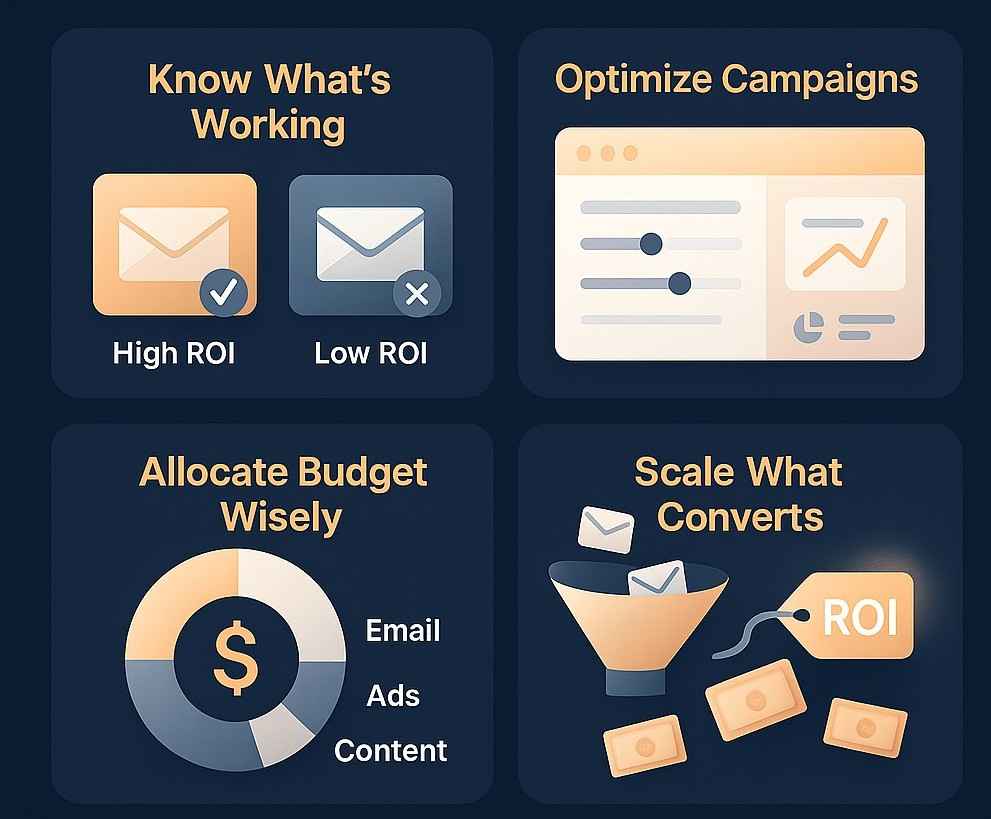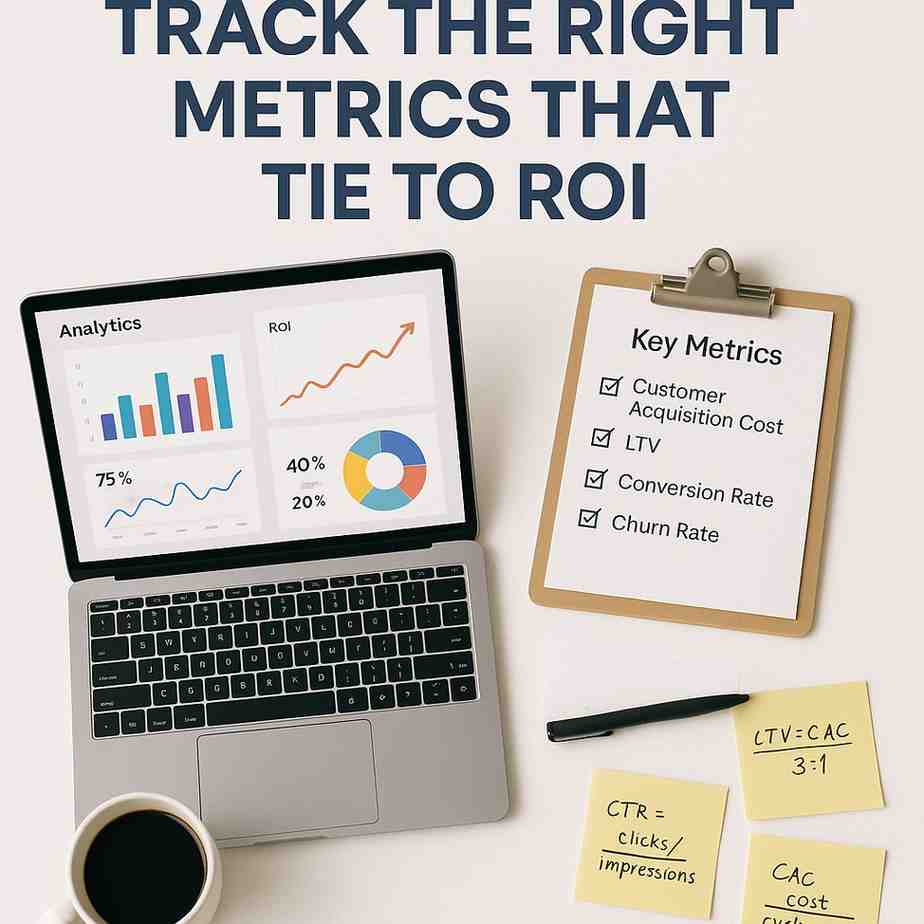It’s not about sending emails. It’s about sending emails that make you money.
But here’s the problem most people face: they have no clue how to accurately measure the ROI on their cold email campaigns. They track opens and replies, sure. But revenue? Pipeline generated? Customer acquisition cost? Nada.
In this article, I’ll walk you through my framework on how I measure the ROI of every cold email campaign I run—and how I optimize it to drive more conversions and sales month after month.
Why Measuring ROI Matters in Cold Emailing

Look, if you’re running cold emails and not tracking the real impact, you’re basically playing a guessing game. Without proper ROI measurement:
You have no idea if you’re profiting or just burning money.
You can’t make data-driven decisions to scale.
You can’t justify outreach as a viable growth channel to clients or stakeholders.
And most importantly? You don’t know what’s working and what’s not. You’re just shooting in the dark.
Step 1: Define What ROI Means to You
Before I even launch a campaign, I start by answering this: What does “return” actually mean for this campaign?
Here are a few common goals I set based on the client or offer:
Booked meetings – if I’m doing appointment-setting for a B2B client.
Sales qualified leads (SQLs) – if the goal is high-quality prospects, not tire-kickers.
Revenue closed – if we want to directly tie emails to sales.
Pipeline value – especially for long sales cycles like SaaS or enterprise services.
Client acquisition cost (CAC) – so I know how much I’m spending per closed deal.
Once I define what “success” looks like, only then do I move to the next steps.
Step 2: Track Your Investment (Every Rupee Counts)
You can’t measure ROI without knowing what you’re putting in. Here’s everything I include in the “investment” part of ROI:
1. Tool Costs
I track tools like:
Instantly / Smartlead / Lemlist
Data providers (Apollo, Clay, Uplead, etc.)
Warm-up tools (Warmbox, Mailreach, etc.)
LinkedIn Sales Navigator (if I’m doing multi-channel)
2. Email Infrastructure Costs
This includes:
I buy custom domains just for cold email.
Mailboxes (Google Workspace or Zoho).
Email warm-up for 2–4 weeks.
3. Human Resources
Whether it’s me, my VA, or a team member doing:
Data scraping
Lead list validation
Personalization and copywriting
Inbox monitoring and follow-ups
I account for hours worked and assign a rough hourly rate.
4. Time
Even if I do everything myself, my time has value. If I’m spending 10 hours setting up a campaign, that’s 10 hours not spent closing deals or scaling the agency.
Once I know the total cost of the campaign, I move to the other side of the equation—returns.
Step 3: Track the Right Metrics That Tie to ROI

Now, here’s where most people mess up. They track vanity metrics like open rates and reply rates and think they’re winning.
But guess what?
An email that gets an 80% open rate but zero meetings is a waste of effort.
Here’s what I track religiously:
1. Open Rate (Top of Funnel Indicator)
Benchmark: 40–70%
Low open rates mean bad subject lines, bad deliverability, or spam folder issues.
2. Reply Rate
Benchmark: 3–10%
But I don’t stop here. I categorize replies into:
Positive
Neutral
Negative
Unsubscribes
3. Positive Reply Rate
This is GOLD. I want to know how many replies show interest.
Benchmark: 1–5% of total emails sent.
If I’m getting 2+% positive replies consistently, the campaign is on the right track.
4. Booked Calls / Meetings
I track this using Calendly, Google Meet bookings, or CRM pipeline stages.
This is where the actual revenue journey begins.
5. Revenue Generated
Here’s how I track this:
I tag leads in the CRM based on the cold email campaign source.
When a deal closes, I tie it back to the campaign it came from.
Even if it closes 30 days later, I can attribute the revenue accurately.
6. Lifetime Value (LTV) of the Client
For services, one client can bring $5k–$50k over a year. Knowing the LTV helps me justify higher upfront outreach costs.
Step 4: Use This Simple ROI Formula
Here’s the cold outreach ROI formula I use:
ROI (%) = [(Revenue – Cost) / Cost] x 100
Example:
Cost of campaign: $800
Revenue from closed clients: $4000
ROI = [($4000 – $800) / $800] x 100 = 400%
That means I made 4x return on that campaign. Solid.
If ROI is negative or below 100%, I dig into why and optimize.
Step 5: Optimize Based on Real ROI Data
Once I’ve run the campaign and tracked the metrics above, here’s how I optimize to increase sales.
1. Low Open Rate?
Change the subject line.
Improve domain reputation.
Warm-up email accounts better.
Use email checker tools to test inbox placement.
2. Low Positive Reply Rate?
Improve the first line. Make it personalized and relevant.
Rewrite the email body to make the offer sharper and clearer.
Test different CTAs. Instead of “Would you be open to a quick chat?”, try “Is this something you’re open to exploring further?”
3. Good Replies but No Sales?
Your offer might be unclear or weak.
You might be attracting unqualified leads.
Your sales call script needs improvement.
Try adding a lead qualification layer before booking.
4. Make your message less aggressive and more helpful.
Include a clear opt-out or signature with legit company info.
Real Case Study: One of My Best-Performing Campaigns
I once ran a cold email campaign for a creative agency targeting SaaS startups.
2,400 emails sent over 3 weeks
49 meetings booked
13 closed deals in 6 weeks
What worked?
I spent real effort scraping high-intent leads.
Used AI-personalized first lines with relevance to the SaaS startup’s features.
The offer wasn’t vague; it clearly said, “We help SaaS companies increase trial-to-paid conversion through better UX-driven storytelling.”
Bonus: Tools That Help Me Track and Measure Cold Email ROI
Here’s my toolkit that I use to track campaigns effectively:
Instantly / Smartlead – for cold outreach automation
Clay + Apollo – for enriched lead lists
Google Sheets + Notion – for ROI tracking manually
Pipedrive / HubSpot CRM – for tracking deal stages and attribution
Calendly – to track meetings booked
Loom – to send personalized video follow-ups (boosts conversions!)
Key Lessons I’ve Learned Over Time
Vanity metrics are seductive, but they don’t pay the bills. Focus on metrics that tie directly to revenue.
Cold email is NOT a volume game. It’s a precision game. The better your list, the better your results.
Personalization still beats automation. Even when scaling, your messaging needs to sound like a human, not a bot.
If you can’t track ROI, don’t run the campaign. Always build tracking into your workflow from the start.
Optimize for sales, not replies. A hundred polite nos don’t help your bank account. Five “Yes, let’s talk” replies from the right people do.
Conclusion: ROI Isn’t Just a Metric—It’s Your Cold Email GPS
Let me be real with you: cold emailing is not dead. It’s not outdated. It’s not spam if done right. It’s still one of the most cost-effective, direct, and scalable channels I’ve used to consistently generate revenue across multiple niches.
But here’s the part most people get wrong—they treat it like a spray-and-pray game, then wonder why it doesn’t work.
If you don’t measure your ROI from the start, you’re not running a campaign… you’re running a gamble.
Over the years, I’ve built and scaled campaigns that failed miserably and others that exploded. What separated the two wasn’t the offer alone, or the copy, or even the data (although all of that matters). It was whether or not I had a system to measure results, pivot based on performance, and constantly optimize toward real revenue, not just engagement.
That’s the entire game.
Why ROI Should Be Your North Star
Too many agency owners, SaaS founders, and even outreach “experts” chase reply rates and open rates, like those metrics alone will grow their business. They won’t.
You can get 70% open rates and 10% reply rates and still close zero deals if the leads are unqualified, your message isn’t converting, or your follow-up sucks.
On the flip side, I’ve run campaigns that only got 3% reply rates—but each reply was pure gold, and the campaign closed multiple high-ticket clients. The only reason I could identify that and scale it fast was because I had ROI tracking built in from Day 1.
That’s the thing about cold outreach: when you measure ROI properly, you stop guessing. You stop “testing ideas” blindly and start taking calculated steps. You’re able to scale winners, fix underperformers, and shut down what’s wasting your time and money.
ROI gives you clarity. And clarity equals control.
The ROI Mindset: Think Like a Business Owner, Not Just a Marketer
If you’ve read this far, I know you’re serious about making cold email work. But let me drive this home one last time: don’t think of cold outreach as a marketing activity. Think of it as a business investment.
You’re spending money on tools, domains, leads, time, and sometimes outsourced help. What do you expect in return? Just a few polite “not interested” emails? No. You want growth. You want meetings. You want sales.
And that mindset shift is huge. Because once you start thinking like a business owner running a revenue channel—not just a marketer sending emails—everything changes.
You start asking the right questions:
Is this campaign profitable?
Which lead source is converting best?
How much am I paying per booked call?
What’s the CAC and LTV from this channel?
Can I scale this profitably without hurting deliverability?
Those are the questions that build a real outbound engine. And you can’t answer any of them without tracking ROI religiously.
And you shouldn’t scale what you can’t justify with numbers.
That’s the power of ROI tracking. It tells you exactly where to look, what to fix, and what to double down on.
The Optimization Loop I Live By
Let me give you a simple loop I use in every campaign:
1. Launch a campaign with clear goals.
Define what ROI means—calls booked, deals closed, or pipeline value.
2. Track costs precisely.
Tools, leads, domains, time—track every dollar and hour.
3. Monitor real metrics, not vanity.
Track positive replies, meetings booked, conversion to sales, and revenue per lead.
4. Analyze weekly.
What’s working? What’s underperforming? Which offers, subject lines, or verticals?
5. Optimize ruthlessly.
Make 1–2 key tweaks, test again, repeat.
6. Scale what works.
Once ROI is proven, double your volume slowly and safely.
This loop is how I’ve taken campaigns from dead zones to money-printing machines. And trust me, it doesn’t require crazy skills. Just discipline and a commitment to tracking the right things.
What Happens When You Get This Right
When you finally get cold email ROI tracking right, a few beautiful things happen:
You stop worrying about vanity metrics.
You start closing deals with intent-driven leads.
You build a repeatable and scalable system.
You impress clients with actual numbers and results.
You make confident decisions because they’re data-backed.
Cold outreach becomes less of a guessing game and more of a calculated growth channel. That’s the level I operate on now. That’s what I help my clients achieve.
I’ll wrap this up with some parting advice—especially if you’re newer to cold outreach or struggling to see real ROI:
1. Start small, but track everything.
You don’t need massive campaigns to learn. Even 100 emails can show you what’s working.
2. Don’t fall for open/reply rate obsession.
Focus on pipeline and revenue, not just engagement.
3. Use a CRM or even a Google Sheet.
Attribution doesn’t have to be fancy. Just be consistent.
4. Do weekly reviews.
And if you embrace that, cold email will never be just “outbound” again.
It’ll be your most reliable growth machine
If you’re serious about using cold email as a predictable sales engine, measuring ROI isn’t optional—it’s the GPS guiding your entire strategy.
For me, once I cracked the code on how to measure ROI properly, everything changed.
I stopped wasting time on campaigns that “looked good” but brought no results.
I doubled down on campaigns with high ROI and scaled them.
I built trust with clients by showing them real numbers.
If you’ve made it this far, here’s my final ask: don’t just read this and nod. Audit your last campaign. Plug your numbers into the ROI formula. Find the leak. Fix it. And keep going.
This is how you win at cold outreach.

